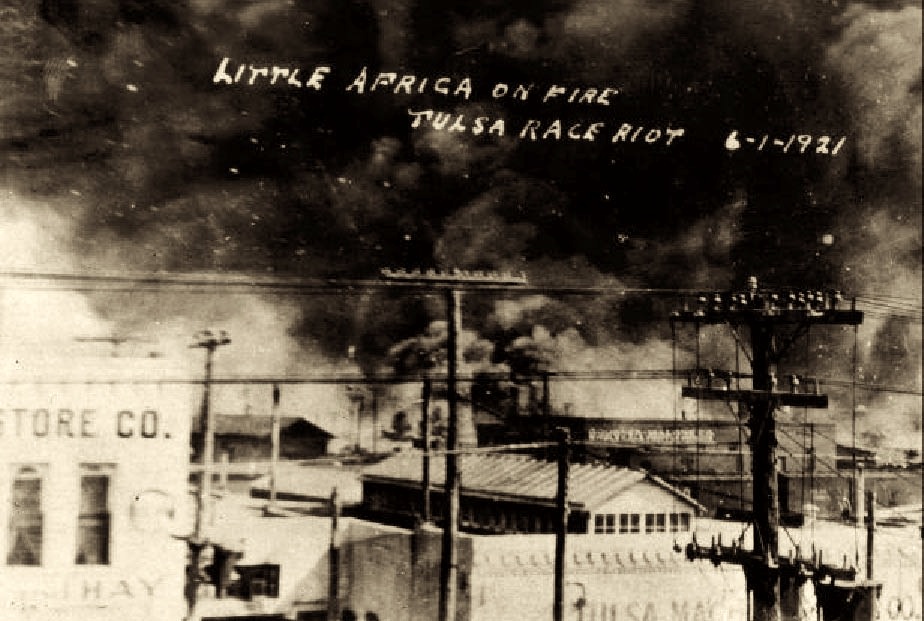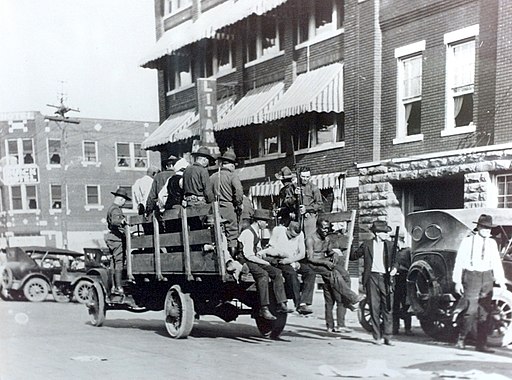The Tulsa Race Massacre, also known as the Tulsa Race Riot remains one of the worst incidents of racial violence in U.S. history, and one that is not told in our history books. With Tulsa being segregated by the north and south, there was only one place to go if you were black and wanted to establish a name for yourself. The Greenwood District, also known as the Mecca for black enterprise and “Black Wall Street” as the community had more than 300 black-owned businesses. This including two theaters, doctors, pharmacists, and even a pilot who owned his own private airplane. Booker T. Washington coined Greenwood the term “Negro Wall Street of America.â€
Occurred over 18 hours on May 31-June 1, 1921, a white mob attacked residents, homes and businesses in the predominantly black neighborhood called Greenwood in Tulsa, Oklahoma.

This image is used with permission of Department of Special Collections and University Archives, McFarlin Library, University of Tulsa.
The Incident
On May 30, 1921, a young 19 year old black teenager named Dick Rowland entered an elevator at the Drexel Building to use the bathroom, an office building on South Main Street in Tulsa. Only one floor was open to blacks. The elevator operator was a young white female by the name of Sarah Page who was 17 years old. According to Rowland, he tried to get on the elevator and tripped, grabbing onto the woman operator. After the elevator closed, Ms. Page ran out screaming while Rowland ran away. A white store clerk reported the incident to police as an assault after seeing Rowland run.

“A few minutes later he entered the elevator she claimed,, and attacked her, scratching her hands and face and tearing her clothes. Her screams brought clerk from Renberg’s store to her assistance, and the negro fled.”
According to the Tulsa Times
Rowland was arrested a few hours later. However, some accounts state that he was arrested the next morning. Page claimed a black man assaulted her, but she didn’t press charges. Instead, the authorities did.
Rumors of what Page said had happened on that elevator had circulated through the city’s white community. It was even on the front page of the Tulsa Tribune and included the name of Dick Rowland. This started outrage in the white community. White outraged citizens demanded that Rowland be released to them so they could lynch him. However, Sheriff Willard McCullough refused and ordered protection of their him.
The Riot
Around 9 p.m., 1,500 whites armed men gathered at the court house. In addition, a group of about 25 black armed gathered outside to try to protect him from being lynched. Some of which were World War I veterans. With both groups being armed, it ended not so well with shots fired. Since the black men were outnumbered they fled the area and headed back to Greenwood.
According to the Tulsa Historical Society and Museum, a white mob started to loot and burn businesses in Greenwood. White people broke into stores in Tulsa to take guns and ammunition so they could head for Greenwood. There were also reports of looting and shooting downtown Tulsa. The white people were given weapons by city officials.
It was on June 1st, and thousands of white citizens gathered into the Greenwood District, looting and burning homes and businesses over an area of 35 city blocks. While six airplanes circled overhead dropping incendiary bombs on black homes and shops. Over 1,256 houses were burned to the ground. They destroyed black businesses. Some included two newspapers, a school, a library, a hospital, churches, hotels, stores and many other black-owned businesses by lighting them on fire and nearly 10,000 people were left homeless. Tulsa Historical Society and Museum believe over 300 black people died. The National Guard arrived and declared martial law shortly before noon. Black Wall Street was destroyed and o June 3rd, Martial law was lifted.

From Wikimedia Commons
The case against Dick Rowland was dismissed at the end of September 1921. The court dismissed Dick Rowland’s case, followed by the receipt of a letter by the County Attorney from Sarah Page in which she stated that she did not wish to prosecute the case.
The Aftermath
Documents related to the riot disappeared soon afterward. The event never received widespread attention and was long noticeably absent from the history books. However, In 1997 a Tulsa Race Riot Commission was formed by the state of Oklahoma to investigate the riot and formally document the incident. According to the Encyclopedia Britannica, the commission suggested that the state of Oklahoma pay $33 million in restitution. Some of the money would go to the 121 surviving victims who they had located. However, no legislative action was ever taken on the recommendation, and the commission had no power to force legislation.
Also Oklahoma would move forward with embedding the story of the 1921 Tulsa Race Massacre into the curriculum of all Oklahoma schools.
Work Cited
Tulsa Race Massacre – HISTORY. https://www.history.com/topics/roaring-twenties/tulsa-race-massacre
Tulsa race riot of 1921 | History & Facts | Britannica. https://www.britannica.com/event/Tulsa-race-riot-of-1921
Untold History: Black Wall Street and the Tulsa Race Riots. https://intpolicydigest.org/2017/09/26/untold-history-black-wall-street-tulsa-race-riots/


